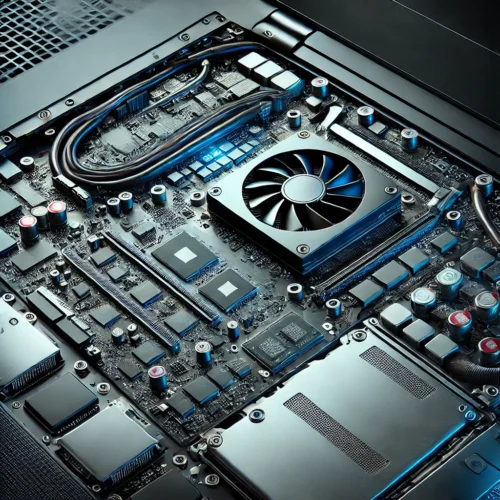Understanding Discrete Graphics Cards
In the world of computers, especially in gaming and professional workstations, you often hear about discrete graphics cards. But what exactly are they, and why do they matter so much? Let’s dive into this essential component of modern computing.
Discrete Graphics Cards are dedicated hardware components designed to handle graphics processing. Unlike integrated graphics, which are built into the CPU, discrete graphics cards are separate units that have their own dedicated memory (VRAM), power supply, and cooling solutions.
Key Features of Discrete Graphics Cards:
- Dedicated VRAM: This is crucial for high-resolution textures and detailed 3D models. Most discrete graphics cards come with 4GB to 16GB of VRAM.
- Powerful GPUs: The GPU (Graphics Processing Unit) on a discrete card is designed specifically for rendering images, animations, and videos quickly and efficiently.
- Enhanced Performance: Discrete graphics cards provide significant performance improvements over integrated graphics, making them ideal for gaming, video editing, and 3D rendering.

Why Discrete Graphics Cards Matter
1. Gaming Performance
For gamers, discrete graphics cards are a must. Games today are visually stunning and require a lot of processing power to run smoothly. A powerful discrete graphics card ensures high frame rates, better resolution, and overall an enhanced gaming experience.
- High Frame Rates: Smooth gameplay requires high frame rates, which discrete graphics cards provide by efficiently processing complex graphics.
- Better Resolution: They allow for higher resolutions, such as 4K, making games look incredibly detailed.
2. Professional Workstations
In professional fields like video editing, 3D modeling, and graphic design, the performance of these graphics cards is indispensable. These cards can handle complex calculations and renderings that would bog down systems relying on integrated graphics.
- Video Editing: Faster rendering times and the ability to work with high-resolution video files.
- 3D Modeling: Smooth manipulation of complex 3D models and faster rendering of scenes.
3. Virtual Reality (VR) and Augmented Reality (AR)
VR and AR applications demand a lot from a computer’s graphics capabilities. Discrete graphics cards provide the necessary power to render immersive environments without lag, which is critical for a seamless VR/AR experience.
4. Multi-Monitor Setups
For users who require multiple monitors for productivity, these graphics cards are essential. They can support several high-resolution displays simultaneously, something integrated graphics often struggle with.
How to Choose a Discrete Graphics Card
When selecting a discrete graphics card, consider the following:
- Purpose: Are you gaming, video editing, or using the card for professional 3D work?
- VRAM: More VRAM is better for high-resolution textures and multiple monitors.
- Compatibility: Ensure your motherboard and power supply can support the card.
- Budget: Prices can range from $100 to over $1500, so pick one that fits your needs and budget.

Popular Discrete Graphics Cards
Here are some of the popular choices in the market today:
- NVIDIA GeForce RTX Series: Known for their ray tracing capabilities and high performance in gaming.
- AMD Radeon RX Series: Offers great performance at competitive prices.
- NVIDIA Quadro Series: Designed for professional workstations with unparalleled performance in 3D rendering and CAD applications.
Is a Discrete Graphics Card Better Than an Integrated Graphics Card?
When it comes to graphics performance, the debate between discrete graphics cards and integrated graphics cards is common. Let’s break down why a discrete graphics card is generally considered better than an integrated graphics card.
Performance
Discrete Graphics Cards have a significant edge in performance. They come with their own dedicated VRAM, allowing them to handle high-resolution textures and complex 3D models with ease. This dedicated memory ensures that your system’s RAM is not being used for graphics processing, leading to smoother and faster performance in graphics-intensive applications like gaming, video editing, and 3D rendering.
Integrated Graphics Cards, on the other hand, share the system’s RAM and are built into the CPU. While they have improved significantly over the years, they still can’t match the performance levels of discrete cards. Integrated graphics are suitable for everyday tasks like browsing, streaming videos, and basic photo editing, but they struggle with more demanding tasks.
Versatility and Upgradability
Discrete graphics cards offer more versatility and upgradability. If you need better performance, you can simply upgrade to a more powerful discrete card without replacing the entire system. Integrated graphics, being part of the CPU, do not offer this flexibility. You would need to upgrade the whole CPU, which can be more costly and less convenient.
Specialized Tasks
For specialized tasks such as virtual reality, high-end gaming, or professional 3D work, discrete graphics cards are essential. They provide the necessary power to handle these tasks efficiently, delivering better visual quality and faster processing times.

Conclusion
Discrete graphics cards play a vital role in modern computing, especially for gaming, professional workstations, VR/AR applications, and multi-monitor setups. They offer superior performance, dedicated resources, and enhanced capabilities that integrated graphics simply cannot match.
For a detailed comparison of integrated graphics performance, check out our post on Can Intel UHD 730 Handle Modern Games? Let’s Find Out!.
You can also visit AnandTech Graphics Reviews for Detailed analysis and performance benchmarks for GPUs.
In conclusion, if you need top-notch graphics performance, investing in a discrete graphics card is the way to go. Whether you’re a gamer, a professional, or someone who loves the latest in technology, a discrete graphics card can significantly enhance your computing experience.
FAQs
Do You Need a Discrete Graphics Card?
Whether you need a discrete graphics card depends on your usage. If you’re into gaming, video editing, 3D rendering, or using multiple monitors, a discrete graphics card is essential. For everyday tasks like browsing, streaming, and basic office work, integrated graphics are usually sufficient.
Is a Discrete GPU Better Than Integrated?
Yes, a discrete GPU is generally better than integrated graphics in terms of performance. Discrete GPUs have dedicated VRAM and processing power, which significantly enhances gaming, video editing, and other graphics-intensive tasks. Integrated graphics, while improving, still share resources with the CPU and system RAM, leading to lower performance.
Does My PC Have a Discrete GPU?
To check if your PC has a discrete GPU, you can look at the system specifications. On Windows, you can check by going to Device Manager and expanding the “Display adapters” section. If you see two entries (one for integrated graphics and another for a discrete GPU), your PC has a discrete graphics card. Alternatively, you can check the specifications listed in your system’s manual or on the manufacturer’s website.
What Are the Disadvantages of a Discrete Graphics Card?
Despite their advantages, discrete graphics cards have a few disadvantages:
- Cost: They are generally more expensive than integrated graphics.
- Power Consumption: Discrete GPUs consume more power, which can lead to higher electricity bills and require a more robust power supply.
- Heat Output: They generate more heat, necessitating better cooling solutions.
- Space: They take up additional space inside the PC case, which can be an issue in compact builds.
